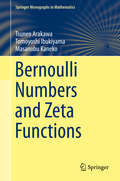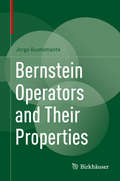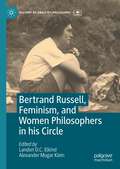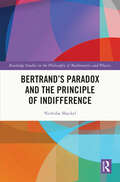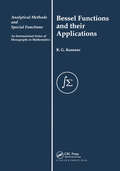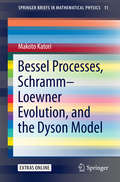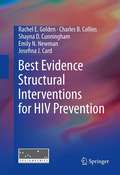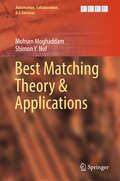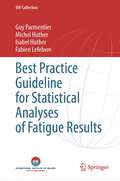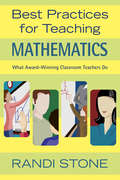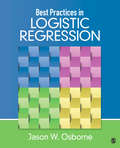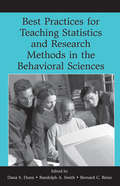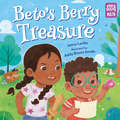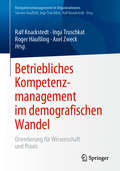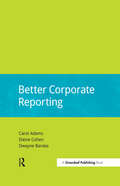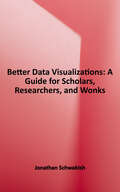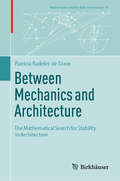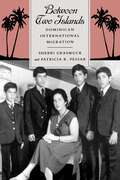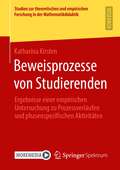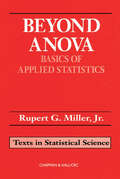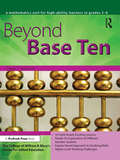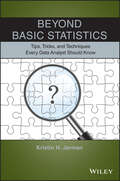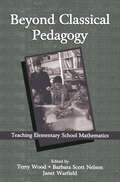- Table View
- List View
Bernoulli Numbers and Zeta Functions (Springer Monographs in Mathematics)
by Tsuneo Arakawa Tomoyoshi Ibukiyama Masanobu KanekoTwo major subjects are treated in this book. The main one is the theory of Bernoulli numbers and the other is the theory of zeta functions. Historically, Bernoulli numbers were introduced to give formulas for the sums of powers of consecutive integers. The real reason that they are indispensable for number theory, however, lies in the fact that special values of the Riemann zeta function can be written by using Bernoulli numbers. This leads to more advanced topics, a number of which are treated in this book: Historical remarks on Bernoulli numbers and the formula for the sum of powers of consecutive integers; a formula for Bernoulli numbers by Stirling numbers; the Clausen-von Staudt theorem on the denominators of Bernoulli numbers; Kummer's congruence between Bernoulli numbers and a related theory of p-adic measures; the Euler-Maclaurin summation formula; the functional equation of the Riemann zeta function and the Dirichlet L functions, and their special values at suitable integers; various formulas of exponential sums expressed by generalized Bernoulli numbers; the relation between ideal classes of orders of quadratic fields and equivalence classes of binary quadratic forms; class number formula for positive definite binary quadratic forms; congruences between some class numbers and Bernoulli numbers; simple zeta functions of prehomogeneous vector spaces; Hurwitz numbers; Barnes multiple zeta functions and their special values; the functional equation of the doub le zeta functions; and poly-Bernoulli numbers. An appendix by Don Zagier on curious and exotic identities for Bernoulli numbers is also supplied. This book will be enjoyable both for amateurs and for professional researchers. Because the logical relations between the chapters are loosely connected, readers can start with any chapter depending on their interests. The expositions of the topics are not always typical, and some parts are completely new.
Bernoulli's Fallacy: Statistical Illogic and the Crisis of Modern Science
by Aubrey ClaytonThere is a logical flaw in the statistical methods used across experimental science. This fault is not a minor academic quibble: it underlies a reproducibility crisis now threatening entire disciplines. In an increasingly statistics-reliant society, this same deeply rooted error shapes decisions in medicine, law, and public policy with profound consequences. The foundation of the problem is a misunderstanding of probability and its role in making inferences from observations.Aubrey Clayton traces the history of how statistics went astray, beginning with the groundbreaking work of the seventeenth-century mathematician Jacob Bernoulli and winding through gambling, astronomy, and genetics. Clayton recounts the feuds among rival schools of statistics, exploring the surprisingly human problems that gave rise to the discipline and the all-too-human shortcomings that derailed it. He highlights how influential nineteenth- and twentieth-century figures developed a statistical methodology they claimed was purely objective in order to silence critics of their political agendas, including eugenics.Clayton provides a clear account of the mathematics and logic of probability, conveying complex concepts accessibly for readers interested in the statistical methods that frame our understanding of the world. He contends that we need to take a Bayesian approach—that is, to incorporate prior knowledge when reasoning with incomplete information—in order to resolve the crisis. Ranging across math, philosophy, and culture, Bernoulli’s Fallacy explains why something has gone wrong with how we use data—and how to fix it.
Bernstein Operators and Their Properties
by Jorge BustamanteThis book provides comprehensive information on the main aspects of Bernstein operators, based on the literature to date. Bernstein operators have a long-standing history and many papers have been written on them. Among all types of positive linear operators, they occupy a unique position because of their elegance and notable approximation properties. This book presents carefully selected material from the vast body of literature on this topic. In addition, it highlights new material, including several results (with proofs) appearing in a book for the first time. To facilitate comprehension, exercises are included at the end of each chapter. The book is largely self-contained and the methods in the proofs are kept as straightforward as possible. Further, it requires only a basic grasp of analysis, making it a valuable and appealing resource for advanced graduate students and researchers alike.
Bertrand Russell, Feminism, and Women Philosophers in his Circle (History of Analytic Philosophy)
by Landon D. C. Elkind Alexander Mugar KleinThis book examines Bertrand Russell’s complicated relationships to the women around him, and to feminism more generally. The essays in this volume offer scholarly reassessments of these relationships and their import for the history of feminism and of analytic philosophy.Russell is a founder of analytic philosophy. He has also been called a feminist due to his public, decades-long advocacy for women’s rights and equality of the sexes. But his private behavior towards wives and sexual partners, and his apparently dismissive (occasionally public) responses to some women philosophers, raises the question of what sort of feminist (or chauvinist) Russell actually was.Focusing on women in Russell’s circle of acquaintance, including feminist activists and his philosophical interlocutors, this book casts new light on a timeless thinker’s feminism and the women who played critical roles in the making of analytic philosophy.
Bertrand’s Paradox and the Principle of Indifference (Routledge Studies in the Philosophy of Mathematics and Physics)
by Nicholas ShackelEvents between which we have no epistemic reason to discriminate have equal epistemic probabilities. Bertrand’s chord paradox, however, appears to show this to be false, and thereby poses a general threat to probabilities for continuum sized state spaces. Articulating the nature of such spaces involves some deep mathematics and that is perhaps why the recent literature on Bertrand’s Paradox has been almost entirely from mathematicians and physicists, who have often deployed elegant mathematics of considerable sophistication. At the same time, the philosophy of probability has been left out. In particular, left out entirely are the philosophical ground of the principle of indifference, the nature of the principle itself, the stringent constraint this places on the mathematical representation of the principle needed for its application to continuum sized event spaces, and what these entail for rigour in developing the paradox itself. This book puts the philosophy and its entailments back in and in so doing casts a new light on the paradox, giving original analyses of the paradox, its possible solutions, the source of the paradox, the philosophical errors we make in attempting to solve it and what the paradox proves for the philosophy of probability. The book finishes with the author’s proposed solution—a solution in the spirit of Bertrand’s, indeed—in which an epistemic principle more general than the principle of indifference offers a principled restriction of the domain of the principle of indifference.Bertrand's Paradox and the Principle of Indifference will appeal to scholars and advanced students working in the philosophy of mathematics, epistemology, philosophy of science, probability theory and mathematical physics.
Bessel Functions and Their Applications
by B G KorenevBessel functions are associated with a wide range of problems in important areas of mathematical physics. Bessel function theory is applied to problems of acoustics, radio physics, hydrodynamics, and atomic and nuclear physics. Bessel Functions and Their Applications consists of two parts. In Part One, the author presents a clear and rigorous intro
Bessel Processes, Schramm-Loewner Evolution, and the Dyson Model (SpringerBriefs in Mathematical Physics #11)
by Makoto KatoriThe purpose of this book is to introduce two recent topics in mathematical physics and probability theory: the Schramm-Loewner evolution (SLE) and interacting particle systems related to random matrix theory. A typical example of the latter systems is Dyson's Brownian motion (BM) model. The SLE and Dyson's BM model may be considered as "children" of the Bessel process with parameter D, BES(D), and the SLE and Dyson's BM model as "grandchildren" of BM. In Chap. 1 the parenthood of BM in diffusion processes is clarified and BES(D) is defined for any D ≥ 1. Dependence of the BES(D) path on its initial value is represented by the Bessel flow. In Chap. 2 SLE is introduced as a complexification of BES(D). Rich mathematics and physics involved in SLE are due to the nontrivial dependence of the Bessel flow on D. From a result for the Bessel flow, Cardy's formula in Carleson's form is derived for SLE. In Chap. 3 Dyson's BM model with parameter β is introduced as a multivariate extension of BES(D) with the relation D = β + 1. The book concentrates on the case where β = 2 and calls this case simply the Dyson model. The Dyson model inherits the two aspects of BES(3); hence it has very strong solvability. That is, the process is proved to be determinantal in the sense that all spatio-temporal correlation functions are given by determinants, and all of them are controlled by a single function called the correlation kernel. From the determinantal structure of the Dyson model, the Tracy-Widom distribution is derived.
Best Evidence Structural Interventions for HIV Prevention
by Josefina J. Card Charles B. Collins Rachel E Golden Emily N Newman Shayna D CunninghamProviding detailed information on structural HIV prevention interventions, this book is intended for health care practitioners and researchers to plan, implement, and evaluate such interventions in their own communities. As defined by the CDC, structural interventions focus on the physical, social, cultural, political, economic, legal, and/or policy aspects of the environment. Designed to reach a large number of individuals, structural interventions usually occur across entire communities, cities, or countries. As a result, the resources required to initiate structural interventions can far exceed those required for smaller-scale behavioral programs. However, changes from structural interventions have the potential to last over time, even after the programs have ended, resulting in effective use of public and private prevention resources. Because the reach of structural interventions is typically larger than that of individual- or group-focused interventions (for example, the 100% Condom Use Program, which was implemented countrywide in Thailand), their influence may be equally--if not more--significant.This book is a resource for health practitioners, educators, and researchers who seek HIV/AIDS structural prevention programs that have been shown to be effective in their regions or for their target populations (e.g. injection drug users, commercial sex workers, or the general public). With extensive case studies, the book classifies interventions according to the desired outcomes (specific behavior or policy changes) so that the reader may focus on examples of programs with similar goals and target populations to their own. Addresses the quintessential public health ethical dilemma regarding which types of environmental changes should be mandatory via legislation and which should be voluntary, promoted via programmatic, practice, and policy change.
Best Matching Theory & Applications (Automation, Collaboration, & E-Services #3)
by Shimon Y. Nof Mohsen MoghaddamMismatch or best match? This book demonstrates that best matching of individual entities to each other is essential to ensure smooth conduct and successful competitiveness in any distributed system, natural and artificial. Interactions must be optimized through best matching in planning and scheduling, enterprise network design, transportation and construction planning, recruitment, problem solving, selective assembly, team formation, sensor network design, and more. Fundamentals of best matching in distributed and collaborative systems are explained by providing: #65533; Methodical analysis of various multidimensional best matching processes #65533; Comprehensive taxonomy, comparing different best matching problems and processes #65533; Systematic identification of systems' hierarchy, nature of interactions, and distribution of decision-making and control functions #65533; Practical formulation of solutions based on a library of best matching algorithms and protocols, ready for direct applications and apps development. Designed for both academics and practitioners, oriented to systems engineers and applied operations researchers, diverse types of best matching processes are explained in production, manufacturing, business and service, based on a new reference model developed at Purdue University PRISM Center: "The PRISM Taxonomy of Best Matching". The book concludes with major challenges and guidelines for future basic and applied research in the area of best matching.
Best Practice Guideline for Statistical Analyses of Fatigue Results (IIW Collection)
by Guy Parmentier Michel Huther Isabel Huther Fabien LefebvreThis book provides a comprehensive guidance for the use of sound statistical methods and for the evaluation of fatigue data of welded components and structures obtained under constant amplitude loading and used to produce S-N curves. Recommendations for analyzing fatigue data are available, although they do not deal with all the statistical treatments that may be required to utilize fatigue test results, and none of them offers specific guidelines for analyzing fatigue data obtained from tests on welded specimens. For an easy use, working sheets are provided to assist in the proper statistical assessment of experimental fatigue data concerning practical problems giving the procedure and a numerical application as illustration.
Best Practices for Teaching Mathematics: What Award-Winning Classroom Teachers Do
by Randi B. StoneSpark students' interest in math with intriguing and winning strategies that include animated learning icons, money-based systems, human number lines, "sweet" solutions, and much more.
Best Practices in Logistic Regression
by Jason W. OsborneJason W. Osborne’s Best Practices in Logistic Regression provides students with an accessible, applied approach that communicates logistic regression in clear and concise terms. The book effectively leverages readers’ basic intuitive understanding of simple and multiple regression to guide them into a sophisticated mastery of logistic regression. Osborne’s applied approach offers students and instructors a clear perspective, elucidated through practical and engaging tools that encourage student comprehension.
Best Practices in Teaching Statistics and Research Methods in the Behavioral Sciences
by Dana S. Dunn Randolph A. Smith Bernard C. BeinsThis book provides a showcase for "best practices" in teaching statistics and research methods in two- and four-year colleges and universities.A helpful resource for teaching introductory, intermediate, and advanced statistics and/or methods, the book features coverage of:ways to integrate these courseshow to promote ethical conducthow to create wr
Beto's Berry Treasure (Storytelling Math)
by Jenny LacikaCelebrate diversity, math, and the power of storytelling!Beto wants to play tea party with Cora, but his big sister just wants to be a pirate. To get Cora on board, Beto makes a map to a delicious hidden treasure. But Cora ends up in the wrong place! Will Cora find the treasure before Beto eats it all? A playful exploration of mapping, featuring Chicanx (Mexican American) characters and a glossary of Spanish words.Storytelling Math celebrates children using math in their daily adventures as they play, build, and discover the world around them. Joyful stories and hands-on activities make it easy for kids and their grown-ups to explore everyday math together. Developed in collaboration with math experts at STEM education nonprofit TERC, under a grant from the Heising-Simons Foundation.
Betriebliches Kompetenzmanagement im demografischen Wandel: Orientierung für Wissenschaft und Praxis (Kompetenzmanagement in Organisationen)
by Inga Truschkat Axel Zweck Ralf Knackstedt Roger HäußlingDie in diesem Fachbuch präsentierten Orientierungshilfen ermöglichen einen Überblick über die große Vielfalt der in Wissenschaft und Praxis in den letzten Jahren entwickelten Problemlösungen für das betriebliche Kompetenzmanagement. Als Leserin oder Leser lernen Sie Werkzeuge kennen, um für das Kompetenzmanagement relevante Lösungsansätze zu identifizieren, wichtige Trends zu erkennen und den in der eigenen Organisation erreichten Entwicklungsstand kritisch zu reflektieren. Die präsentierten Ansätze zeigen Synergiepotenziale zwischen wissenschaftlichen Erkenntnissen und praktischen Methoden auf und helfen Ihnen daher sowohl in der wissenschaftlichen Forschung wie auch in der Praxis.
Better Corporate Reporting (Doshorts Ser.)
by Carol Adams Elaine Cohen Dwayne BarakaBetter Corporate Reporting outlines the latest frameworks for enhancing non-financial and sustainability reporting. It shows you how to integrate non-financial data into your reporting and overall strategy, creating long-term value, trust and transparency. It includes guides to: the International Integrated Reporting Council's new framework; the Global Reporting Initiative's G4 framework; and a detailed look at the concept at the heart of both of these new frameworks, materiality. It is the compilation of 3 bestselling sustainability guides on sustainability reporting.Understanding Integrated Reporting provides a practical and expert distillation of the new IR framework released by the International Integrated Reporting Council in December 2013. It explains what IR is and how to do it; how it links with other reporting frameworks and what it means in terms of thinking and processes. You'll also get a clear business case for IR and insights and best practice examples from leading integrated reporters. The Global Reporting Initiative (GRI) G4 Sustainability Reporting Framework was launched in May 2013. In Understanding G4, corporate reporting veteran Elaine Cohen presents an easy-to-follow review of everything any organization needs to know to decide whether to use the G4 Framework and if so, how. Materiality is the lynch-pin that can align your sustainability initiatives with your overall strategy. Making Sustainability Matter shows you how to identify your organization's most material sustainability issues, allocate resources to sustainability initiatives for optimal returns; connect your communications and reporting to materiality, and; clarify which issues are important to your stakeholders. Materiality is a core concept in both the GRI's new G4 framework the IIRC's new Integrated Reporting framework.
Better Data Visualizations: A Guide for Scholars, Researchers, and Wonks
by Jonathan SchwabishNow more than ever, content must be visual if it is to travel far. Readers everywhere are overwhelmed with a flow of data, news, and text. Visuals can cut through the noise and make it easier for readers to recognize and recall information. Yet many researchers were never taught how to present their work visually. This book details essential strategies to create more effective data visualizations. Jonathan Schwabish walks readers through the steps of creating better graphs and how to move beyond simple line, bar, and pie charts. Through more than five hundred examples, he demonstrates the do’s and don’ts of data visualization, the principles of visual perception, and how to make subjective style decisions around a chart’s design. Schwabish surveys more than eighty visualization types, from histograms to horizon charts, ridgeline plots to choropleth maps, and explains how each has its place in the visual toolkit. It might seem intimidating, but everyone can learn how to create compelling, effective data visualizations. This book will guide you as you define your audience and goals, choose the graph that best fits for your data, and communicate your message.
Between Mechanics and Architecture: The Mathematical Search for Stability in Architecture (Mathematics and the Built Environment #8)
by Patricia Radelet-de GraveThis collection of essays reflects the author's decades-long dedication to studying the interplay between mechanics and architecture. It explores how advancements in mechanics have influenced architectural innovation and how the need for new architectural solutions has driven theoretical progress in engineering. By examining the historical roots of these fields, these essays provide a deep analysis of key developments. This interdisciplinary work will appeal to scholars, students, and anyone interested in the complex relationship between the theoretical and practical aspects of architecture and civil engineering.
Between Two Islands: Dominican International Migration
by Patricia R. Pessar Sherri GrasmuckPopular notions about migration to the United States from Latin America and the Caribbean are too often distorted by memories of earlier European migrations and by a tendency to generalize from the more familiar cases of Mexico and Puerto Rico. Between Two Islands is an interdisciplinary study of Dominican migration, challenging many widespread, yet erroneous, views concerning the socio-economic background of new immigrants and the causes and consequences of their move to the United States.Eschewing monocausal treatments of migration, the authors insist that migration is a multifaceted process involving economic, political, and socio-cultural factors. To this end, they introduce an innovative analytical framework which includes such determinants as the international division of labor; state policy in the sending and receiving societies; class relations; transnational migrant households; social networks; and gender and generational hierarchies.By adopting this multidimensional approach, Grasmuck and Pessar are able to account for many intriguing paradoxes of Dominican migration and development of the Dominican population in the U.S. For example, why is it that the peak in migration coincided with a boom in Dominican economic growth? Why did most of the immigrants settle in New York City at the precise moment the metropolitan economy was experiencing stagnation and severe unemployment? And why do most immigrants claim to have achieved social mobility and middle-class standing despite employment in menial blue-collar jobs?Until quite recently, studies of international migration have emphasized the male migrant, while neglecting the role of women and their experiences. Grasmuck and Pessar's attempt to remedy this uneven perspective results in a better overall understanding of Dominican migration. For instance, they find that with regard to wages and working conditions, it is a greater liability to be female than to be without legal status. They also show that gender influences attitudes toward settlement, return, and workplace struggle.Finally, the authors explore some of the paradoxes created by Dominican migration. The material success achieved by individual migrant households contrasts starkly with increased socio-economic inequality in the Dominican Republic and polarized class relations in the United States.This is an exciting and important work that will appeal to scholars and policymakers interested in immigration, ethnic studies, and the continual reshaping of urban America.
Beweisprozesse von Studierenden: Ergebnisse einer empirischen Untersuchung zu Prozessverläufen und phasenspezifischen Aktivitäten (Studien zur theoretischen und empirischen Forschung in der Mathematikdidaktik)
by Katharina KirstenKatharina Kirsten untersucht, wie Studierende beim Konstruieren von Beweisen im Bereich der Analysis vorgehen. Im Rahmen einer explorativ-deskriptiven Untersuchung analysiert sie die Beweisprozesse von Studienanfängerinnen und -anfängern mithilfe einer typenbildenden qualitativen Inhaltsanalyse. Als Grundlage dient ein Phasenmodell, welches die kognitiven Vorgänge einer Beweiskonstruktion gebündelt darstellt. Die Ergebnisse umfassen Erkenntnisse zur allgemeinen Struktur eines Beweisprozesses sowie zu spezifischen Aktivitäten in den Phasen des Verstehens und des Validierens. Aus dem Vergleich erfolgreicher und weniger erfolgreicher Beweisprozesse leitet die Autorin Hypothesen über wirksame Vorgehensweisen und hiermit verbundene Schwierigkeiten ab.
Bewerten und bewertet werden im Mathematikunterricht (BestMasters)
by Yasmin DagherBewertungen im Unterricht können mithilfe verbaler und nonverbaler Kommunikationsmittel erfolgen. Dabei lassen sie sich als feine Mechanismen beschreiben, die Einschätzungen von Leistung mitbestimmen können. Schüler*innen können sie außerdem Aufschluss darüber geben, welche Anforderungen in Bezug auf Verhalten oder Unterrichtsbeiträge an sie gestellt werden. Die vorliegende qualitative Forschungsarbeit bietet einen Einblick in die Bewertungspraxis im Mathematikunterricht. Dabei wird aufgezeigt, wie Bewertungen erfolgen und insbesondere, wie diese von Schüler*innen wahrgenommen werden. Mit der Durchführung von Gruppendiskussionen wird ein Zugang zu den Wahrnehmungen von Schüler*innen ermöglicht und ihre Perspektive auf Bewertungssituationen analysiert und dargestellt.
Beyond ANOVA: Basics of Applied Statistics (Chapman & Hall/CRC Texts in Statistical Science)
by Jr., Rupert MillerRenowned statistician R.G. Miller set the pace for statistics students with Beyond ANOVA: Basics of Applied Statistics. Designed to show students how to work with a set of "real world data," Miller's text goes beyond any specific discipline, and considers a whole variety of techniques from ANOVA to empirical Bayes methods; the jackknife, bootstrap
Beyond Base Ten: A Mathematics Unit for High-Ability Learners in Grades 3-6
by Dana T. JohnsonLooking for a way to challenge your gifted students in math class? Look no further! Beyond Base Ten investigates the concept of place value and the representation of numbers by using place value and non-place-value systems. Number bases other than Base Ten are featured, especially through historical contexts of early civilizations that developed number systems different from the one we use today.Place value is a fundamental and powerful concept that is the foundation for the number system used by all cultures. Typical curriculum materials address this concept in a rote method. This unit goes beyond this and encourages students to analyze the structure of our number system and other systems; examine the historical foundations of place value systems (Babylonian and Mayan) and non-place-value systems (Roman and Greek) over thousands of years in different civilizations; analyze why Base Ten is the surviving number system; and investigate applications of other number bases in areas such as computers and electricity. Beyond Base Ten is perfect for any student who loves mathematics!Beyond Base Ten was developed by the Center for Gifted Education at The College of William and Mary.Grades 3-6
Beyond Basic Statistics
by Kristin H. JarmanFeatures basic statistical concepts as a tool for thinking critically, wading through large quantities of information, and answering practical, everyday questions Written in an engaging and inviting manner, Beyond Basic Statistics: Tips, Tricks, and Techniques Every Data Analyst Should Know presents the more subjective side of statistics--the art of data analytics. Each chapter explores a different question using fun, common sense examples that illustrate the concepts, methods, and applications of statistical techniques. Without going into the specifics of theorems, propositions, or formulas, the book effectively demonstrates statistics as a useful problem-solving tool. In addition, the author demonstrates how statistics is a tool for thinking critically, wading through large volumes of information, and answering life's important questions. Beyond Basic Statistics: Tips, Tricks, and Techniques Every Data Analyst Should Know also features: Plentiful examples throughout aimed to strengthen readers' understanding of the statistical concepts and methods A step-by-step approach to elementary statistical topics such as sampling, hypothesis tests, outlier detection, normality tests, robust statistics, and multiple regression A case study in each chapter that illustrates the use of the presented techniques Highlights of well-known shortcomings that can lead to false conclusions An introduction to advanced techniques such as validation and bootstrapping Featuring examples that are engaging and non-application specific, the book appeals to a broad audience of students and professionals alike, specifically students of undergraduate statistics, managers, medical professionals, and anyone who has to make decisions based on raw data or compiled results.
Beyond Classical Pedagogy: Teaching Elementary School Mathematics (Studies in Mathematical Thinking and Learning Series)
by Terry Wood Barbara Scott Nelson Janet WarfieldThe emergence of the National Council of Teachers of Mathematics Standards in 1989 sparked a sea change in thinking about the nature and quality of mathematics instruction in U.S. schools. Much is known about transmission forms of mathematics teaching and the influence of this teaching on students' learning, but there is still little knowledge about the alternative forms of instruction that have evolved from the recent widespread efforts to reform mathematics education. Beyond Classical Pedagogy: Teaching Elementary School Mathematics reports on the current state of knowledge about these new instructional practices, which differ in significant ways from the traditional pedagogy that has permeated mathematics education in the past. This book provides a research-based view of the nature of facilitative teaching in its relatively mature form, along with opposing views and critique of this form of pedagogy. The focus is on elementary school mathematics classrooms, where the majority of the reform-based efforts have occurred, and on the micro level of teaching (classroom interaction) as a source for revealing the complexity involved in teaching, teachers' learning, and the impact of both on children's learning. The work in elementary mathematics teaching is situated in the larger context of research on teaching. Research and insights from three disciplinary perspectives are presented: the psychological perspective centers on facilitative teaching as a process of teachers' learning; the mathematical perspective focuses on the nature of the mathematical knowledge teachers need in order to engage in this form of teaching; the sociological perspective attends to the interactive process of meaning construction as teachers and students create intellectual communities in their classrooms. The multidisciplinary perspectives presented provide the editors with the necessary triangulation to provide confirming evidence and rich detail about the nature of facilitative teaching. Audiences for this book include scholars in mathematics education and teacher education, teacher educators, staff developers, and classroom teachers. It is also appropriate as a text for graduate courses in mathematics education, teacher education, elementary mathematics teaching methods, and methods of research in mathematics education.
